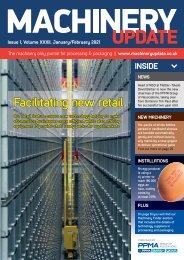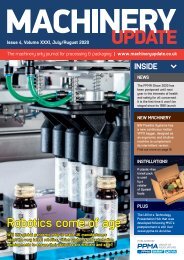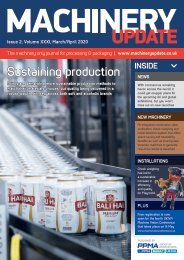MU July \ August 2017
Create successful ePaper yourself
Turn your PDF publications into a flip-book with our unique Google optimized e-Paper software.
58 MACHINERY UPDATE JULY/AUGUST <strong>2017</strong> www.machineryupdate.co.uk<br />
Feature: Automation, robotics and vision<br />
We read many<br />
articles<br />
discussing<br />
Industry 4.0 and<br />
the Industrial<br />
Internet of Things and<br />
defining these concepts can<br />
be difficult. However what<br />
these and other similar ideas<br />
clearly introduce is a forward<br />
thinking mindset and this has<br />
in some cases already led to<br />
smart manufacturing, where<br />
intelligent machines, systems<br />
and networks are capable of<br />
independently exchanging<br />
and responding to information<br />
to manage industrial<br />
production processes.<br />
Smart manufacturing looks<br />
at the complete holistic view<br />
from customer demand and<br />
order processing, control of<br />
raw materials and ingredients<br />
to flexible and efficient plant<br />
production, while minimising<br />
waste, energy usage and also<br />
downtime.<br />
It sounds very easy and<br />
what production director<br />
worth their salt wouldn’t<br />
immediately sanction<br />
investment to create their own<br />
smart manufacturing plant?<br />
In fact there are instances,<br />
across many industry sectors<br />
where new manufacturing<br />
plants, or new production<br />
facilities in existing plants,<br />
have been designed from the<br />
word go to deliver a smart<br />
manufacturing concept.<br />
Mitsubishi Electric’s Kani<br />
factory in Japan is a perfect<br />
example of this, deploying<br />
its e-F@ctory manufacturing<br />
methodology to achieve a<br />
smart production facility.<br />
PLANT UPGRADE NEEDS<br />
However, in many cases the<br />
luxury of new plant is not<br />
the reality and more likely<br />
the current plant will need<br />
to be upgraded to meet the<br />
requirements and enjoy<br />
the benefits of the smart<br />
manufacturing concept.<br />
‘Smart’ in its simplest<br />
form, is about gathering<br />
data from the manufacturing<br />
process, turning that data<br />
into information and then<br />
Mitsubishi says that true smart manufacturing is about having a reliable, efficient plant that can adapt swiftly and reduce<br />
errors and downtime. If manufacturers do not invest in the concept they are likely to be left behind their competitors, it claims<br />
Producing in<br />
a smart way<br />
Chris Evans from Mitsubishi Electric talks about what<br />
is meant by smart manufacturing and the benefits<br />
acting on that information.<br />
You could say that what is<br />
needed is intelligent data<br />
from the plant in order to<br />
make decisions that improve<br />
productivity and efficiency<br />
while minimising waste,<br />
energy usage and downtime<br />
It is important to understand<br />
that this intelligent data has<br />
to come from the sharp end<br />
of the process and it is clear<br />
from the advancement<br />
of sensor and actuator<br />
technology that these devices<br />
now deliver self-determination<br />
and advanced error checking<br />
as well as the traditional<br />
process information that is<br />
crucial for control, production<br />
analysis and preventative<br />
maintenance alike.<br />
The next crucial step of<br />
course is connecting various<br />
plant assets and systems<br />
together. Traditionally a<br />
production plant may have<br />
consisted of islands of<br />
automation but in order to<br />
maximise the data gathering<br />
potential, existing or even<br />
new infrastructures must<br />
be utilised to create an<br />
architecture for data<br />
collection and also data<br />
management.<br />
This is made more difficult<br />
if the production facility, as<br />
many are, is controlled by a<br />
disparate array of automation<br />
equipment from different<br />
vendors with no overall<br />
common network strategy.<br />
Thankfully, this problem<br />
is not insurmountable, and<br />
one technique is to overlay a<br />
data gathering layer on top<br />
of the existing automation<br />
control layer to communicate<br />
with and extract data from<br />
these disparate systems. It is<br />
therefore vitally important to<br />
choose an automation vendor<br />
for this task who has a flexible


















